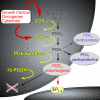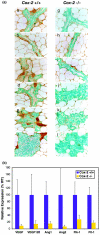Inflammation and breast cancer. Cyclooxygenase/prostaglandin signaling and breast cancer
- PMID: 17640394
- PMCID: PMC2206709
- DOI: 10.1186/bcr1678
Inflammation and breast cancer. Cyclooxygenase/prostaglandin signaling and breast cancer
Abstract
Many human cancers exhibit elevated prostaglandin (PG) levels due to upregulation of cyclooxygenase-2 (COX-2), a key enzyme in eicosanoid biosynthesis. COX-2 over-expression has been observed in about 40% of cases of invasive breast carcinoma and at a higher frequency in preinvasive ductal carcinoma in situ tumors, Extensive pharmacologic and genetic evidence implicates COX enzymes in neoplasia. Epidemiologic analyses demonstrate a protective effect of COX-inhibiting nonsteroidal anti-inflammatory drugs with respect to human cancer. Complementary experimental studies have established that both conventional nonsteroidal anti-inflammatory drugs and selective COX-2 inhibitors suppress mammary tumor formation in rodent breast cancer models. Furthermore, knocking out Cox-2 reduces mammary tumorigenesis and angiogenesis, and, conversely, transgenic COX-2 over-expression induces tumor formation. The utility of COX/PG signaling as a target for chemoprevention has been established by randomized controlled clinical trials. However, these studies also identified increased cardiovascular risk associated with use of selective COX-2 inhibitors. Thus, current efforts are directed toward identifying safer approaches to antagonizing COX/PG signaling for cancer prevention and treatment, with a particular focus on PGE2 regulation and signaling, because PGE2 is a key pro-tumorigenic prostanoid.
Figures





Similar articles
-
The role of COX-2 inhibition in breast cancer treatment and prevention.Semin Oncol. 2004 Apr;31(2 Suppl 7):22-9. doi: 10.1053/j.seminoncol.2004.03.042. Semin Oncol. 2004. PMID: 15179621 Review.
-
Cyclooxygenase-2 (COX-2), aromatase and breast cancer: a possible role for COX-2 inhibitors in breast cancer chemoprevention.Ann Oncol. 2002 May;13(5):669-78. doi: 10.1093/annonc/mdf125. Ann Oncol. 2002. PMID: 12075734 Review.
-
Cyclooxygenase-2 expression in human breast cancers and adjacent ductal carcinoma in situ.Cancer Res. 2002 Mar 15;62(6):1676-81. Cancer Res. 2002. PMID: 11912139
-
Mediators of PGE2 synthesis and signalling downstream of COX-2 represent potential targets for the prevention/treatment of colorectal cancer.Biochim Biophys Acta. 2006 Aug;1766(1):104-19. doi: 10.1016/j.bbcan.2006.05.002. Epub 2006 May 23. Biochim Biophys Acta. 2006. PMID: 16859832 Review.
-
Cyclooxygenase-2-prostaglandin E2-eicosanoid receptor inflammatory axis: a key player in Kaposi's sarcoma-associated herpes virus associated malignancies.Transl Res. 2013 Aug;162(2):77-92. doi: 10.1016/j.trsl.2013.03.004. Epub 2013 Apr 6. Transl Res. 2013. PMID: 23567332 Free PMC article. Review.
Cited by
-
Suppression of inflammatory cascade is implicated in methyl amooranin-mediated inhibition of experimental mammary carcinogenesis.Mol Carcinog. 2014 Dec;53(12):999-1010. doi: 10.1002/mc.22067. Epub 2013 Jul 12. Mol Carcinog. 2014. PMID: 23846978 Free PMC article.
-
The IL1β-IL1R signaling is involved in the stimulatory effects triggered by hypoxia in breast cancer cells and cancer-associated fibroblasts (CAFs).J Exp Clin Cancer Res. 2020 Aug 10;39(1):153. doi: 10.1186/s13046-020-01667-y. J Exp Clin Cancer Res. 2020. PMID: 32778144 Free PMC article.
-
Prostaglandin E2 Receptor 4 (EP4) as a Therapeutic Target to Impede Breast Cancer-Associated Angiogenesis and Lymphangiogenesis.Cancers (Basel). 2021 Feb 24;13(5):942. doi: 10.3390/cancers13050942. Cancers (Basel). 2021. PMID: 33668160 Free PMC article. Review.
-
EP3 Is an Independent Prognostic Marker Only for Unifocal Breast Cancer Cases.Int J Mol Sci. 2020 Jun 22;21(12):4418. doi: 10.3390/ijms21124418. Int J Mol Sci. 2020. PMID: 32580276 Free PMC article.
-
Portrait of inflammatory response to ionizing radiation treatment.J Inflamm (Lond). 2015 Feb 18;12:14. doi: 10.1186/s12950-015-0058-3. eCollection 2015. J Inflamm (Lond). 2015. PMID: 25705130 Free PMC article.
References
Publication types
MeSH terms
Substances
Grants and funding
LinkOut - more resources
Full Text Sources
Other Literature Sources
Medical
Research Materials

